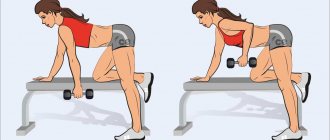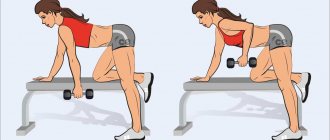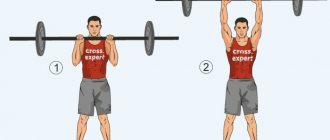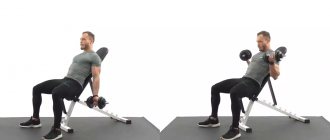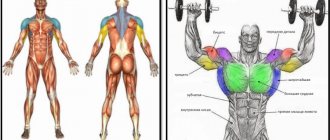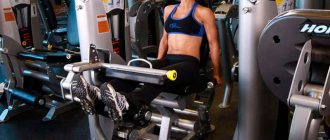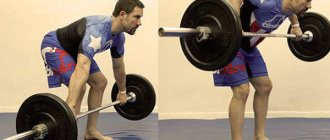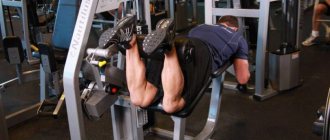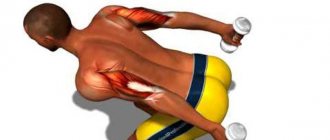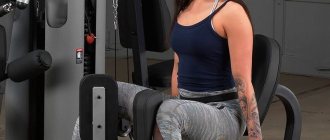August 20, 2015 Admin Home page » Rear deltoid
The technique of performing dumbbell raises to the sides, a training video, other exercises for the rear delta, the starting position and muscles being trained, important tips, common mistakes and a variety of exercise are described.
Standing dumbbell raises - this exercise is aimed at developing the youngest sister of the deltoid muscle family. Indeed, if you look at the structure of the shoulder muscles, it is the smallest of all, but this does not reduce its importance. Without sufficient hypertrophy (muscle enlargement) this is a bunch of deltas, the effect of those very “round balls” of shoulders is not achieved, or rather they will be if you look at a person from the front, but from the side it will be completely different and so dear readers, enough words, let’s get down to business :
Technique for performing dumbbell raises while standing
Having taken the correct starting stance, begin to raise the dumbbells to the side, lifting them up, raising the dumbbells to shoulder level, and the shoulders should rise above shoulder level, while the palms turn back during the movement, with the little finger up. At the top point we do not pause and immediately return to the starting position back.
To achieve the best result, do the same, but rest your forehead on a soft surface, and make your back parallel to the floor (the angle between the floor and your back is 45 degrees), this will increase the load on the rear delts, while relieving the load on the lower back.
Don’t forget about breathing, remember that there are negative (putting effort on the muscle) and positive (relaxing the muscle) phases of movement, therefore exhale during the negative, and inhale during the positive.
Muscles involved
During the exercise, different muscle groups are involved.
Basic
As already mentioned, two parts of the deltoid muscles - the middle and the back.
Additional
A considerable load falls on additional muscles :
- anterior bundle of deltoid muscle;
- trapezoid;
- serratus anterior;
- biceps.
Common wiring mistakes
• When lifting the dumbbells to the top point, the body rises up; with all your might, hold it in the same position as at the beginning of the movement;
• Never tilt your head forward too much, as you round your back and the load goes to the middle of your back;
• Do not raise your shoulders or contract your shoulder blades, you should feel the rear deltoid, do not raise your elbow above shoulder level.
• Many people doing bent-over dumbbell raises do not bend their elbows, this is a GREAT MISTAKE, the elbows should be slightly bent, this relieves tension in the elbow joints and the load on the rear delts is felt better.
• At the top of the exercise, the elbows point back. Another mistake, they must look up and not back; if that doesn’t work, take less weight and bend over even more.
• When lifting dumbbells, do not move your elbows back; your elbows should rise approximately in line with the rear deltoid. If you raise your elbows at the level of the middle of your back, part of the load will go to the lower and middle part of the trapezius;
• Do not throw dumbbells at the beginning of the movement, the load on the deltoids will decrease, which will lead to a decrease in the effect of the exercise, take less weight and do it correctly.
• Many people do exercises with straight legs, this is a mistake, you need to bend them a little, thanks to this it is easier to keep your back in a straight position.
Description and benefits of the exercise
Those who want to get round, pumped up muscles and beautiful shoulders should perform an exercise to work the middle and posterior deltoid muscles. This muscle group is quite difficult to develop, since they are not involved in everyday life or in any sports, and there are not many exercises for their development.
Therefore, you need to use an isolation exercise that specifically affects this muscle group. This is where swinging dumbbells to the sides while standing comes to the rescue - to work the middle bundle of the deltoid muscles and while bending over or sitting - for the rear bundle.
With the help of such swings, with the correct technique, you can get broad shoulders and make your figure as masculine and athletic as possible.
Human muscles are very different, and their recovery takes different amounts of time. So, the triceps recover the fastest, and the back muscles take the longest. 48 hours are needed for the body to fully recover after an intense workout.
SLAP damage
Until recently, establishing a diagnosis of SLAP injury was very difficult. With the development of MRI diagnostics and improvement of arthroscopic technologies, this pathology has become mandatory in the practice of shoulder surgery.
SLAP (superior labrum anterior posterior) is characterized by separation of the fibrous lip from the glenoid in its upper segment with anterior and posterior distribution. In this localization, the tendon of the long head of the biceps begins from the fibrous lip, which is the main vector of traction during injury.
The cause of damage is most often trauma: a fall with support on the abducted arm, a blow to the shoulder area, often found in “throwing” athletes (handball, baseball, water polo), boxers.
Conservative treatment rarely leads to full recovery, because a return to specific loads provokes a recurrence of pain and progression of the rupture.
However, in patients without heavy physical and sports activities, complex therapy provides long-term relief from pain. First of all, rest is ensured for the shoulder joint by fixing the arm on a support bandage. Anti-inflammatory non-steroidal drugs are prescribed. To reduce the inflammatory reaction and reduce pain, physiotherapeutic procedures are necessarily used, such as phonophoresis with drugs, high-intensity laser (HILT), shock wave therapy (SWT), massage, and taping. Stimulation of regeneration is achieved by taking chondroprotectors and intra-articular administration of platelet-rich plasma (PRP). After inflammation has been relieved and the resting stage has been completed, proper rehabilitation under the supervision of a physical therapist will be an important factor in restoring function.
Arthroscopic fixation of the fibrous labrum, by analogy with the usual dislocation of the shoulder, is the most rational method of treatment, because ensures precise restoration of anatomical structures. Low-traumatic surgery reduces rehabilitation time. Under camera control, anchors are installed into the glenoid cavity of the scapula and the fibrous lip is returned to its place using non-absorbable sutures.
Symptoms of the disease
Shoulder pain manifests itself in different ways depending on the cause. Acute is typical in case of injury. When a bruise, dislocation or sprain occurs, the patient experiences discomfort that increases when moving the upper limb. When a fracture occurs, it becomes impossible to move the arm.
Unbearable pain radiating to the neck and upper back is observed with capsulitis. In addition to pain, there is an inability to move the arm back or raise it. Severe pain also occurs with brachial neuritis and arthritis. The first is characterized by the absence of signs of inflammation in the joint; in the second case, swelling of the soft tissues and limited range of motion are noticeable.
Aching pain in the shoulder may be a sign of osteochondrosis of the cervicothoracic spine. Often the symptom is accompanied by numbness of the hand, burning and tingling sensation in the fingers. Aching pain is also observed with deforming arthrosis, but in this case, along with discomfort, a person notes stiffness of movement and swelling in the shoulder joint in the morning, crunching and clicking when bending/extending the arm. With the gradual destruction of cartilage, lifting heavy objects or active movement provokes increased pain.
Constant pain for several weeks is characteristic of bursitis, when the inflammatory process develops in the periarticular bursa. The disease is accompanied by the formation of a compaction, upon pressing on which a fluid transfusion is felt.
What is the cause of the unpleasant crunching sound?
If the shoulder “crunches,” there is a high probability that there is damage to the scapulothoracic joint. As a rule, it occurs due to frequently repeated physical activity in a position with arms raised up. If the shape of the chest is even slightly changed, pain may occur. With osteoarthritis of the shoulder joint, with bone growths, imbalance in the shoulder girdle and curvature of the spine become pronounced.
Don't fight the consequences - look for the cause of the clicks in the shoulder
The basics of proper training
This exercise can only be effective if performed technically correctly.
Standing and sitting technique
Let's look point by point at how to perform abductions with dumbbells to the side to get the maximum impact.
standing
- In the starting position, we stand straight, feet shoulder-width apart, keep our back straight, and look forward.
- The arms are slightly bent at the elbows and slightly turned inward, with dumbbells weighing 3 to 5 kg in each hand. The shoulders are kept as low as possible to avoid engaging the trapezius muscles.
- We take a deep breath, hold our breath and raise our arms strictly horizontally and to the sides, reaching shoulder level. It is important to hold the dumbbells so that your little finger is slightly higher than your other fingers. When lifting, the elbow goes first, and only then the dumbbell, and not vice versa.
- When your hands reach the top point at shoulder level, exhale and smoothly lower the dumbbells to your hips. Without stopping, we do the next repetition.
- We work at a calm and moderate pace.
Cost of treating shoulder pain in our Center
| Services list | Price |
| Initial consultation with a kinesiotherapist | 1600 |
| Interim consultation with a kinesiotherapist | for free |
| Session with a kinesiotherapist (1 patient) | 3900 |
| Individual lessons with a personal trainer | 2700 |
| Subscription for 1 month of training in the gym on simulators | 10 000 |
| Subscription for 6 months of gym training | 45 000 |
| Physiotherapist consultations | 1600 |
| Physiotherapist consultations during the cycle | for free |
| UVT 1 procedure | 2000 |
| HIVAMAT up to 15 min./1 body unit | 2200 |
| HIVAMAT up to 15 min./2 body units | 3200 |
| Appointment with an orthopedist-traumatologist | 1600 |
| Intra-Articular PRP Injection | 6500 |
| Massage of one upper limb (15 min.) | 2200 |
| Massage of two upper limbs (30 min.) | 3000 |
| Kinesio taping | 1100 |
| Complex taping (joints) 1 zone | 1600 |
| Complex taping (joints) 2 zones | 2200 |
Contact us
Call now
8 (495) 803-27-45
Make an appointment through our service
Make an appointment
Who's at risk
A crunch in the shoulder with pain occurs more often in young people who play certain sports. Particularly dangerous are activities in which throwing movements are performed or the arms are often raised upward. Those at risk include builders, painters, hairdressers and conductors. Due to prolonged sitting at a computer, muscle tone suffers, so in the absence of periodic exercise, programmers, system administrators and representatives of other IT professions also run the risk of hearing a characteristic click.
Snapping shoulder syndrome is a common condition among hairdressers.
Impingement syndrome of the shoulder joint
Now, in addition to the three shoulder muscles discussed above, there are also bones and tendons that make up the joint.
In short, there are a lot of moving parts.
In fact, the shoulder is perhaps the most complex joint in the body, with the exception of the wrists and ankles. Because it must rotate in almost all directions. And it is the “moving parts” that can cause problems in the form of damage and pain if dumbbell side swings are performed incorrectly.
It is important to note that pain does not appear immediately.
It depends on the person.
Some people experience pain within a few months of starting swings, while for others it can take years. But in truth, this mistake of internally rotating the shoulders with the thumb turned down almost always results in pain.
We're not talking about tearing it, but we are dealing with the supraspinatus tendon when we do dumbbell lateral swings.
When the thumbs point upward, the entire shoulder rotates outward (backward rotation).
Now let's look at why this matters.
If the shoulders are not externally rotated during the swing, then when the arms are raised parallel to the shoulders (or higher), the supraspinatus tendon becomes pinched between the head of the humerus and the acromion.{banner_st-d-1}
However, you probably won't feel anything at all when the pinching occurs.
But after months or years of training, the supraspinatus tendons wear out, and this almost always leads to pain due to soft tissue damage (shoulder impingement syndrome).
But all people are different.
In other words, no two shoulders are the same.
This simply means that you can do dumbbell lateral swings for many years before pain occurs. On the other hand, sometimes pain appears even after a couple of months.
